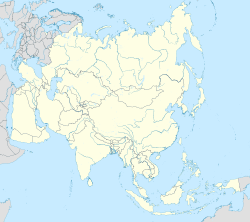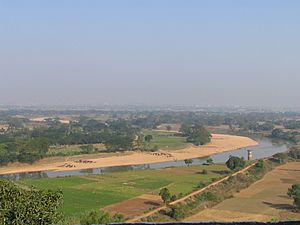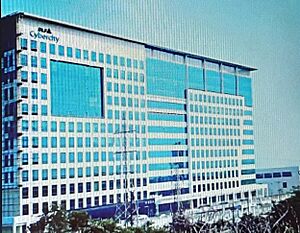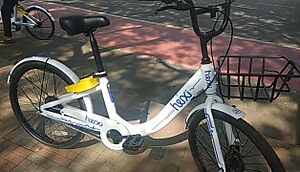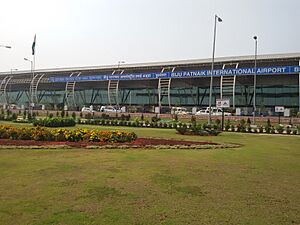Bhubaneswar facts for kids
Quick facts for kids
Bhubaneswar
Temple City, Ekamra Khetra
|
|
|---|---|
|
City
|
|
|
Skyline of Bhubaneswar
Khandagiri Caves
Rajarani Temple
Lingaraja Temple
Kalinga Stadium
|
|
| Nicknames:
Temple City of Odisha
|
|
| Country | |
| State | |
| District | Khordha |
| Founded by | Government of Odisha |
| Named for | Shiva |
| Government | |
| • Type | Municipal Corporation |
| • Body | Bhubaneswar Municipal Corporation (BMC) |
| Area | |
| • Total | 135 km2 (52 sq mi) |
| Elevation | 45 m (148 ft) |
| Population
(2024)
|
|
| • Total | 837,000 |
| • Density | 6,200/km2 (16,060/sq mi) |
| Demonym(s) | Bhubaneswariya |
| Languages | |
| • Official | Odia, English |
| Time zone | UTC+5:30 (IST) |
| PIN |
751024, 751020, 751022
|
| Telephone code | 0674, 06752 |
| Vehicle registration | OD-02 (South Bhubaneswar) OD-33 (North Bhubaneswar) |
| UN/LOCODE | IN BBI |
| Website | |
Bhubaneswar is the capital city of the Indian state of Odisha. It is the second largest city in Odisha, right after Cuttack. You can find it in the Khordha district. Bhubaneswar is becoming a major center for sports and a growing hub for IT companies.
Long ago, the area around the old town was known as Chakra Khetra and Ekamra Khetra, which means "Area adorned with a mango tree." Bhubaneswar is often called the "Temple City" because it has so many ancient temples.
Even though the modern city of Bhubaneswar was officially started in 1968, its history goes back to the 1st century BCE. It's a special place where Hindu, Buddhist, and Jain cultures meet. Many beautiful Kalingan temples here were built between the 6th and 13th centuries CE. Along with Puri and Konark, Bhubaneswar forms the "Swarna Tribhuja" (meaning "Golden Triangle"). This is one of Eastern India's most popular places to visit.
Bhubaneswar took over as the capital from Cuttack in 1968. The modern city was planned by a German architect named Otto Königsberger in 1966. It was one of India's first planned cities, like Jamshedpur and Chandigarh. Bhubaneswar and Cuttack are often called the 'twin cities of Odisha' because they are so close. Together, these two cities had about 1.7 million people in 2011. Bhubaneswar is also one of the "smart cities" in India.
Contents
- What Does the Name Bhubaneswar Mean?
- A Look at Bhubaneswar's Past
- Exploring Bhubaneswar's Geography
- Bhubaneswar's Economy
- People of Bhubaneswar
- Public Services in Bhubaneswar
- Education in Bhubaneswar
- Getting Around Bhubaneswar
- Bhubaneswar's Culture and Traditions
- Sports in Bhubaneswar
- Media and News
- Famous People from Bhubaneswar
- Sister Cities
- Images for kids
- See also
What Does the Name Bhubaneswar Mean?
The name "Bhubaneswar" comes from the Odia word "Bhubaneśwara" (ଭୁବନେଶ୍ୱର). This word comes from Tribhubaneśwara (ତ୍ରିଭୁବନେଶ୍ୱର), which means "Lord of the Three Worlds." This name refers to Shiva, a very important Hindu god.
A Look at Bhubaneswar's Past
Bhubaneswar is located near the old ruins of Sisupalgarh. Close by, Dhauli was the site of the famous Kalinga War around 262-261 BCE. In this war, the Mauryan emperor Ashoka took over Kalinga. You can still see one of Ashoka's most complete messages, called edicts, carved into a rock about 8 km (5 miles) from the modern city. These carvings are from between 272 and 236 BCE.
After the Mauryan empire declined, the area was ruled by the Mahameghavahana dynasty. Their most famous ruler was Kharavela. His important Hathigumpha inscription is found at the Udayagiri and Khandagiri Caves near Bhubaneswar. Over time, many other dynasties ruled here, including the Satavahanas, Guptas, Matharas, and Shailodbhavas.
In the 7th century, the Somavamshi (also called Keshari dynasty) built many temples in the area. After them, the Eastern Gangas ruled Kalinga until the 14th century CE. Their capital was in Cuttack City. Later, Mukunda Deva of the Bhoi Dynasty was the last Hindu ruler before the Marathas took over. Most of the older temples in Bhubaneswar were built between the 8th and 12th centuries, mainly for the god Shiva. The Ananta Vasudeva Temple is special because it's the only old temple dedicated to Vishnu in the city. In 1568, the Karrani dynasty from Afghanistan took control and unfortunately destroyed or damaged many temples and buildings.
In the 16th century, the area came under Mughal rule. Later, the Marathas took over in the mid-18th century and encouraged people to visit religious sites in Odisha. In 1803, the British took control. The capital of Odisha was still Cuttack, but it often flooded and didn't have enough space. So, in 1966, a plan was made to move the capital. The foundation for the new capital was laid on April 13, 1968, after India became independent.
The new capital was named "Bhubaneswar" after "Tribhubaneswara" or "Bhubaneswara," a name for Shiva, the god of the Lingaraja temple. The Legislative Assembly of Odisha moved from Cuttack to Bhubaneswar in 1969. Bhubaneswar was designed as a modern city by German architect Otto Königsberger, with wide roads and parks. Even though parts of the city followed the plan, it grew very quickly. In 1951, the town had only 16,000 people. By 1991, the population had grown to 411,542. Because of this growth, the Bhubaneswar Municipal Corporation was created on August 14, 1994.
Exploring Bhubaneswar's Geography
Bhubaneswar is located in the Khordha district of Odisha. It sits on the eastern coastal plains, near the Eastern Ghats mountains. The city is about 45 meters (148 feet) above sea level. Bhubaneswar is also part of the Mahanadi River Delta.
The Daya River is about 4 km (2.5 miles) to the south, and the Kuakhai River is 4 km (2.5 miles) to the east. The Chandaka Wildlife Sanctuary is to the west, and the Nandankanan Zoo is to the north of Bhubaneswar.
The city has two main types of land: western uplands and eastern lowlands. There are small hills in the western and northern parts. Kanjia lake on the northern edge is important for its rich biodiversity and is a special wetland. Most of Bhubaneswar's soil is laterite (65%), with some alluvial (25%) and sandstone (10%) soil. The city is in a moderate earthquake zone (Zone III). It also has a "very high damage risk" from strong winds and cyclones. The 1999 Odisha cyclone caused a lot of damage to buildings and the city. Flooding in lower areas is common due to unplanned growth.
How Bhubaneswar is Organized
The Bhubaneswar urban area includes the city itself, 173 villages, and two other towns, covering about 1,110 square kilometers (429 sq mi). The main city area managed by the Bhubaneswar Municipal Corporation is about 186 square kilometers (72 sq mi). The city looks a bit like a dumbbell, with most of its growth happening in the north, northeast, and southwest. The widest part of the city, from north to south, is about 22.5 km (14 miles). Growth to the east is limited by the Kuakhai River and a wildlife sanctuary in the northwest.
The city can be divided into a few main parts:
- The Old Town: This is the oldest part, known for its many temples like Lingaraja Temple, Rajarani Temple, and Muktesvara temples. These temples are mixed in with homes. This area can be crowded with narrow roads.
- The Planned City: This part was designed in 1948 to be the capital. It's divided into "units," each with schools, shops, and play areas. Many government workers live here. Unit V has important government buildings like the State Secretariat and State Assembly. Other areas like Saheed Nagar and Satya Nagar have private homes. Unit I, also called the Market Building, was made for shopping. Later, more markets grew along Janpath and Cuttack-Puri Road. There's also a special area for schools and research centers, including Utkal University and the Institute of Physics. Parks like Indira Gandhi Park are also found here.
- Added Areas: These are newer areas, mostly north of National Highway 5, like Nayapalli and Chandrasekharpur. They were developed to house the growing population. Now, the city is roughly divided into North (newer areas) and South Bhubaneswar (older areas) by the NH-5 highway.
- Peripheral Areas: These are outside the main city limits or were added later. Many of these areas grew without much planning.
Bhubaneswar was ranked as the top "Smart City" in India.
Bhubaneswar's Climate
Bhubaneswar has a tropical savanna climate. This means it's usually warm or hot. Temperatures generally range from 11°C (52°F) to 44°C (111°F). The city has five main seasons:
- Winter (December to January): Temperatures can drop to about 11°C (52°F).
- Spring (February)
- Summer (March to May): Temperatures can reach 44°C (111°F) or even higher.
- Monsoon (June to October): This is when most of the rain falls.
- Post-monsoon (November)
The average yearly temperature is about 27.4°C (81.3°F). Summers are hot and humid, often above 30°C (86°F). May is the hottest month, with daily temperatures from 32°C (90°F) to 42°C (108°F). January is the coldest, with temperatures from 15°C (59°F) to 28°C (82°F). The highest temperature ever recorded was 46.7°C (116.1°F) on June 5, 2012. The lowest was 8.2°C (46.8°F) on December 30, 2018.
Most of the rain comes from the southwest summer monsoon between June and September. Bhubaneswar gets about 1657.8 mm (65.27 inches) of rain each year. August usually has the most rain.
Bhubaneswar was ranked as the 7th best "National Clean Air City" in India for cities with 3-10 lakh (300,000-1,000,000) people in 2024.
Bhubaneswar's Economy
Bhubaneswar is an important city for government work, IT, education, and tourism. In 2014, the World Bank said Bhubaneswar was the best place in India to start a business. It has become a fast-growing center for trade and business in Eastern India. Tourism is a big industry, bringing about 1.5 million visitors in 2011.
Bhubaneswar was planned to be mostly a city for living, with industrial areas outside. Before the 1990s, its economy was mainly small shops and factories. But after India started its economic liberalization policy in the 1990s, Bhubaneswar received investments in telecommunications, IT, and higher education.
In 2011, a study found that Bhubaneswar had the highest job growth among 17 medium-sized cities in India. It's also listed among the top ten growing cities in India by Cushman and Wakefield, thanks to its population, buildings, social services, economy, and government support. In 2012, the World Bank ranked Bhubaneswar third among Indian cities for how easy it is to start and run a business.
Bhubaneswar has a long history of handicrafts, like silver filigree work, appliqué work, stone and wood carvings, and patta painting. These crafts add a lot to the city's economy. In the late 2000s, there was a big increase in investments for real estate, buildings, shops, and hotels. Many shopping malls opened in Bhubaneswar.
As of 2001, most of the city's workers (95.67%) were in the service industries (like IT, tourism, education). A smaller number worked in farming (2.15%) or manufacturing (2.18%).
The government has set up four industrial areas around Bhubaneswar. These areas have industries that make paper, steel, cars, food, medicines, and electronics. Many companies like Odisha State Cooperative Milk Producers' Federation, Bharat Biotech, and Britannia Industries have factories here.
In 2009, Odisha was ranked ninth in India for software exports, with most IT companies in Bhubaneswar. In 2011–12, software exports from Odisha grew by 17%. A 2012 survey found Bhubaneswar to be the best medium-sized city in India for IT business. The government helped this growth by creating IT parks like Infocity-1. Big companies like Infosys, Tech Mahindra, Accenture, Cognizant, and Tata Consultancy Services have offices here. Also, about 300 smaller IT companies and startups are in Bhubaneswar.
Lulu International Shopping Malls Private Limited plans to build shopping malls and other facilities with a large investment.
People of Bhubaneswar
How Many People Live Here?
| Historical population | ||
|---|---|---|
| Year | Pop. | ±% |
| 1951 | 16,512 | — |
| 1961 | 38,211 | +131.4% |
| 1971 | 105,491 | +176.1% |
| 1981 | 227,525 | +115.7% |
| 1991 | 423,465 | +86.1% |
| 2001 | 647,302 | +52.9% |
| 2011 | 837,737 | +29.4% |
According to the 2011 census of India, Bhubaneswar had a population of 837,737 people. The larger metropolitan area had 881,988 people. Experts from IIT Kharagpur estimate that the Bhubaneswar–Cuttack area had 1.9 million people in 2008. In 2011, there were 445,233 males and 392,504 females. The population grew by 45.90% in ten years.
How Many People Can Read and Write?
Bhubaneswar has a very high literacy rate of 93.15%. This is much higher than India's national average of 74.04%. For males, the literacy rate was 95.69%, and for females, it was 90.26%. About 75,237 children were under six years old.
What Languages are Spoken?
The main language spoken in Bhubaneswar is Odia. However, most people also understand English and Hindi. While most residents are Odias, many people have moved here from other states like Andhra Pradesh, Bihar, West Bengal, Rajasthan, and Jharkhand. The growth of the IT and education sectors has changed who lives in the city. This rapid growth has sometimes caused challenges for the city's services.
What Religions are Practiced?
Religion in Bhubaneshwar Hindus (95.24%) Muslims (3.29%) Christians (0.92%) Sikhs (0.12%) Others (0.43%)
Bhubaneswar is home to people of many different religions. Most people in the city are Hindus, making up over 95% of the population in 2011. Muslims are the second largest group (3.3%), followed by Christians (0.92%). There are also smaller groups of Sikhs, Buddhists, and Jains.
Public Services in Bhubaneswar
Electricity in the city is now supplied by TATA Power-TP-CODL. The Odisha Fire Service handles fire emergencies. Drinking water comes from the Mahanadi, Kuakhai, and Daya rivers. The Public Health Engineering Organisation manages water supply and sewerage. In 2015, about 35% of the city had piped water connections.
About 26.7% of the city has a sewage network. For other areas, homes use septic tanks. There isn't a large sewage treatment plant yet, but one is being built. The city's waste is managed by the municipal corporation. They collect garbage from homes using special vehicles and are trying to encourage people to separate wet and dry waste. Most waste is disposed of in landfills.
Companies like BSNL, Reliance Jio, Bharti Airtel, and Vodafone Idea provide telephone, cell phone, and internet services in the city.
Education in Bhubaneswar
Bhubaneswar is a major center for higher education in Eastern India. It has many government and private universities and colleges. Some of the top institutions in the country are located here, including IIT Bhubaneswar, NISER Bhubaneswar, AIIMS Bhubaneswar, and NIFT Bhubaneswar. Utkal University Bhubaneswar is the oldest university in Odisha and the 17th oldest in India.
Schools for Kids and Teens
Schools in Bhubaneswar mainly teach in Odia and English. They follow the "10+2+3" plan for regular college degrees and "10+2+4" for technical studies. Schools are run by either the state government or private groups. Students usually attend schools linked to boards like BSE, Odisha, CBSE, or Council for the Indian School Certificate Examinations.
Some well-known government schools include:
- Kendriya Vidyalaya No. 1, Bhubaneswar
- Sainik School
- Capital High School, Bhubaneswar
Popular private schools include:
- DAV Public School, Pokhariput, Bhubaneswar
- Sai International School, Bhubaneswar
Colleges and Universities
Many colleges are connected to universities in Bhubaneswar or other parts of India. They offer a wide range of programs in science, technology, engineering, and math (STEM). Many are highly rated by the Indian government.
Some important institutions are:
- Indian Institute of Technology Bhubaneswar
- International Institute of Information Technology, Bhubaneswar (IIIT-BBSR)
- Kalinga Institute of Industrial Technology
- National Institute of Science Education and Research (NISER)
- All India Institute of Medical Sciences Bhubaneswar
- Utkal University
- XIM University
Getting Around Bhubaneswar
Bicycles for Rent
Bhubaneswar has a public bicycle sharing program called Mo Cycle. It was started to reduce traffic congestion, encourage cycling, and help people travel the "last mile" to their destinations. The program began in November 2011.
There are about 400 cycle stands across the city, with around 2,000 bicycles available from companies like Hexi, Yaana, and Yulu. You can rent these bikes using a special mobile app called "mo app."
Bus Services
Public transport within the city is handled by the "Mo Bus (My Bus)" service. This service also connects Bhubaneswar to nearby cities like Cuttack and Puri.
The main bus station for travel between states is at Barmunda, about 8 km (5 miles) from the city center. From here, buses connect Bhubaneswar to other cities in Odisha and neighboring states like Andhra Pradesh, Jharkhand, West Bengal, and Chhattisgarh. Bhubaneswar is connected to the rest of India by NH 16, which is part of the Golden Quadrilateral highway system.
Roads in the City
Bhubaneswar has a grid-like road system in its central area. The city has about 1,600 km (994 miles) of roads. The Baramunda Inter State Bus Terminus (ISBT) is the main bus station. From here, buses go to all districts in Odisha and to cities in other states like Hyderabad and Kolkata. The city bus service, called Mo Bus, covers all major areas, including Cuttack, Puri, and Khordha.
Auto rickshaws are available for hire. In some parts of the city, cycle rickshaws are used for short trips. To help with traffic, new over-bridges and wider roads are being built. Bhubaneswar was ranked third among six Indian cities for its pedestrian-friendly paths.
Train Stations
Bhubaneswar has several train stations:
| Station name | Station code | Railway zone | Number of platforms |
|---|---|---|---|
| Bhubaneswar | BBS | East Coast Railway | 6 |
| Mancheswar | MCS | East Coast Railway | 4 |
| Lingaraj Temple Road | LGTR | East Coast Railway | 3 |
| Vani Vihar | BNBH | East Coast Railway | 2 |
| Patia | PTAB | East Coast Railway | 2 |
| New Bhubaneswar | BBSN | East Coast Railway | 7 |
| Barang | BRAG | East Coast Railway | 3 |
The East Coast Railway has its main office in Bhubaneswar. Bhubaneswar railway station is a very important station in India's railway network. It connects to major cities with daily express and passenger trains. There are plans to add two more platforms to handle more trains.
A new station, New Bhubaneswar railway station, opened near Barang in July 2018 to help ease traffic at the main station.
Airport
Biju Patnaik International Airport (IATA: BBI) is the main international airport in Odisha. It's about 3 km (1.9 miles) south of the city center. There are daily flights from Bhubaneswar to major Indian cities like Delhi, Mumbai, and Kolkata. International flights also go to places like Dubai, Singapore, and Bangkok. Major airlines like Indigo and Vistara fly from here. In March 2013, a new domestic terminal opened to handle more passengers. The first international flight took off from Terminal 2 on July 10, 2015.
Bhubaneswar's Culture and Traditions
Bhubaneswar is famous for having over a thousand temples, which is why it's called the 'Temple City of India'. These temples are built in the Kalinga architectural style. This style features a tall, curved spire over the main part of the temple and a pyramid-shaped hall where people gather to pray.
Some of the important temples include Lingaraja Temple, Muktesvara Temple, Rajarani Temple, and Ananta Vasudeva Temple. The Kukutesvara Siva Temple is a small, 1000-year-old shrine dedicated to Shiva.
The twin hills of Khandagiri and Udayagiri were once home to an ancient Jaina monastery. This monastery was carved into cave-like rooms in the hillside and dates back to the 2nd century BCE. At Dhauli hills, you can see important messages from Ashoka carved into a rock. A white Peace Pagoda was also built there in the 1970s. Besides these old temples, newer ones like Ram Mandir and ISKCON have also been built.
Bhubaneswar, along with Cuttack, is the center of the Odia film industry, known as "Ollywood." Most of the state's film studios are located here.
The Odia culture is kept alive through classical Odissi dance, handicrafts, sand art, sculptures, theater, and music. Many walls and gardens in the city are decorated with the folk art of the state. Odissi, one of the oldest classical dance forms in India, has roots that can be seen in the ancient temples of Bhubaneswar.
Odissi Dance
Odissi dance is usually performed with Odissi music. Srjan, a famous Odissi dance academy founded by the legendary dancer Guru Kelucharan Mohapatra, is located here. The Rabindra Mandapa in central Bhubaneswar hosts many cultural events, plays, and private functions.
Clothing Styles
Traditionally, Odia women wear the sari. However, shalwar kameez and Western clothes are becoming popular among younger women. Men often wear Western-style clothes, but traditional dhoti and kurta are still worn during festivals.
The Odisha State Museum displays old artifacts, weapons, local arts, and crafts. It also provides information about Odisha's nature and tribal history. The Tribal Research Institute Museum has real tribal homes built by tribal artists. Nandankanan Zoological Park, on the city's northern edge, was India's first zoo to join the World Association of Zoos and Aquariums. The State Botanical Garden (Odisha), also known as Ekamra Kanan, is a park with many different types of plants. The Ekamra Haat is a market for handmade textiles and crafts. Nicco Park and Ocean World are amusement parks. Other museums include Pathani Samanta Planetarium and Regional Museum of Natural History.
Festivals and Celebrations
On the day of Ashokashtami (in March or April), a procession carries the statue of Lingaraja (Shiva) and other gods from Lingaraja Temple to the Mausima Temple. The gods stay there for four days. Many people help pull the temple car that carries the gods, in a festival called Rukuna Ratha. Ratha-Yatra, or the "Temple Car Festival," is the most important festival in Odisha and Bhubaneswar. This festival celebrates Jagannatha, who is believed to be an incarnation of the gods Vishnu and Krishna. Durga Puja, held in September–October, is also celebrated with great joy.
As part of the Ekamra Festival, several cultural events take place in January in Bhubaneswar. These include Kalinga Mahotsaba (for traditional martial arts), Dhauli-Kalinga Mahotsaba (for classical dance), Rajarani Music Festival (for classical music), and Mukteswara Dance Festival (for Odissi dance). People in Bhubaneswar also enjoy khattis, which are relaxed chats that often turn into interesting discussions.
Other festivals celebrated include Shivaratri, Diwali, Ganesha Chaturthi, Nuakhai, and Saraswati Puja. Eid and Christmas are celebrated by the city's religious minorities.
The Adivasi Mela, held in January, is a fair that shows off the art, crafts, traditions, culture, and music of Odisha's tribal people. The Toshali National Crafts Mela, held in December, features handicrafts from all over India and other countries. Other important fairs include the Rajdhani Book Fair and Khandagiri Utsav. Bhubaneswar also hosts two international literary festivals: Kalinga Literary Festival and Mystic Kalinga Festival.
Delicious Food of Bhubaneswar


The city's food often includes rice and a fish curry called Machha Jhola. For desserts, you can try sweets like Rasagola, Rasabali, Chhena Gaja, Chhena Jhilli, and Chhena Poda. Odisha has many seafood dishes, including different ways of preparing lobsters and crabs from Chilika Lake.
Street foods like gupchup (a crispy fried snack filled with potatoes and peas, dipped in tamarind water), cuttack-chaat, and dahibara aloo dum (fried lentil dumplings in yogurt, served with potato curry) are sold everywhere. Traditional Odia food like dahi-pakhala (rice soaked in water with yogurt) is eaten in the hot months to cool down. It's often served with badi chura or saga.
The abadha (holy food) served at Lingaraja Temple and Ananta Vasudeva Temple is a delicious vegetarian meal. Other vegetarian dishes include Dalma (lentils and vegetables cooked together) and Santula (lightly spiced steamed vegetables).
Sports in Bhubaneswar
Bhubaneswar's main sports area is the Kalinga Stadium. It has facilities for athletics, football, hockey, basketball, tennis, table tennis, and swimming. It hosted the Men's Hockey World Cup in 2018 and again in 2023 (with Rourkela), making it the first city to host two World Cups in a row.
The Kalinga Lancers (a hockey team) and Odisha FC (a football team) are based in Bhubaneswar and play at Kalinga Stadium. The East Coast Railway Stadium is a well-known cricket stadium that hosts matches like the Ranji Trophy.
The Odisha Naval Tata Hockey High Performance Centre, a hockey academy for young players, is also at Kalinga Stadium. An indoor stadium for badminton, volleyball, basketball, and table tennis is being built. Barabati Stadium in Cuttack, the only place in Odisha for international cricket matches, is about 25 km (16 miles) away. Bhubaneswar also has a golf course called Bhubaneswar Golf Club.
The KIIT Stadium is a new multi-purpose stadium at the Kalinga Institute of Industrial Technology University Campus, which can hold 40,000 people.
Bhubaneswar hosted the 2017 Asian Athletics Championships. It was the third Indian city to host this event. The president of the International Hockey Federation (FIH) and the Indian Olympic Association (IOA), Narindar Batra, has said that Bhubaneswar is becoming the new sports capital of India. He noted that the state supports all kinds of sports, including cricket, football, hockey, tennis, badminton, and chess.
Media and News
The city has many popular Odia-language newspapers like Sambad, Dharitri, and Samaja. English-language newspapers produced in Bhubaneswar include Orissa Post and Odia Age. Other widely read English newspapers are The Times of India, The Statesman, and The Hindu. Financial newspapers like The Economic Times are also popular. Newspapers in Hindi, Bengali, and Telugu are read by smaller groups.
All India Radio, the national radio broadcaster, has several channels from Cuttack. Bhubaneswar has five local FM radio stations, including two from AIR. India's state-owned television channel, Doordarshan Odia, offers two free channels. Many other Odia, Hindi, English, and regional channels are available through cable and direct-broadcast satellite services. Some Odia TV channels are Sidarth TV, Manjari, Colors Odia, and Tarang TV. There are also 24-hour Odia news channels like News 7, Odisha TV, and Kanak TV.
Famous People from Bhubaneswar
Here are some notable people who are connected to Bhubaneswar (either born here or spent a lot of their life here):
- Subroto Bagchi
- Ranjib Biswal
- Dutee Chand
- Nabakrushna Choudhury
- Ileana Citaristi
- Pankaj Charan Das
- J. B. S. Haldane
- Baidyanath Misra
- Bijay Mohanty
- Debashish Mohanty
- Gopinath Mohanty
- Kelucharan Mohapatra
- Mira Nair
- Sanjukta Panigrahi
- Biju Patnaik
- Naveen Patnaik
- Sudarsan Pattnaik
- Trilochan Pradhan
- Biswa Kalyan Rath
- Archita Sahu
- Achyuta Samanta
- Pathani Samanta
Sister Cities
Bhubaneswar has sister city relationships with:
 Cupertino, California, United States
Cupertino, California, United States Bloemfontein, South Africa
Bloemfontein, South Africa
Images for kids
See also
 In Spanish: Bhubaneshwar para niños
In Spanish: Bhubaneshwar para niños









